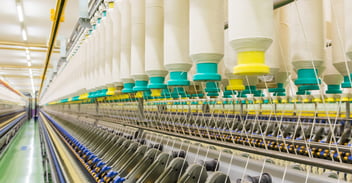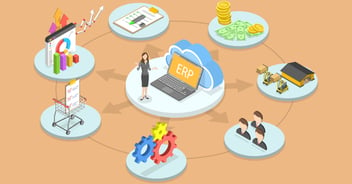

Imagine a factory pouring molten metal into molds, shaping the parts that power our world - car engines, valves, and more. This fiery alchemy is the foundry industry. While the process is fascinating, keeping track of it all can be a nightmare considering the evolving customer demands. While the foundry industry is expected to grow to $229.96 billion in 2028 from $189.69 billion in 2024, the challenges are aplenty, especially with limited digitization and automation.
Like a digital wizard, ERP for foundries swoops in to organize the chaos. It tracks every step, giving foundries real-time data on costs and efficiency. No more guessing games!
With ERP, foundries get:
-
X-ray vision of where each part is in production.
-
Crystal ball to predict costs and optimize pricing.
-
Eagle eyes to spot improvement areas, reduce waste, and boost efficiency.
In short, streamlining foundry operations can lead the path from fiery confusion to a well-oiled machine, ready to meet the evolving demands of the modern world.
Here are some of the ways ERP for foundries creates an impact:
Sales and Planning:
One of the most time-consuming and complicated processes is sales and planning. For instance, in the final week of a month, the sales team would have around 2500+ schedules with a capacity of around 8000 metric tons/annum. Feeding all these data into the system would need more than two resources and an entire day.
However, ERP for foundries can convert 1000+ schedule lines into sale orders in less than 1 minute. The ERP software has an integration tool that allows users to import the exact customer schedules from an Excel sheet into the ERP system. This significantly reduces the operation time from 16 hours to less than 5 minutes and streamlines sales and production planning for foundries.

Production Planning:
Traditionally in foundries, production planning is a complex task. The production team uses sales schedules to create a monthly molding plan, a time-consuming process, to determine the exact mix of materials and capacity needs for each casting.
ERP for foundries simplifies this process. The MRP engine integrates with sales schedules to determine the exact castings and raw materials required. The system generates work orders for each casting along with corresponding purchase requests for all materials. Additionally, it identifies any capacity or material constraints at the work order level, proactively flagging potential bottlenecks. This allows for efficient sales and production planning for foundries, avoiding delays.
Production Reporting:
ERP for foundries simplifies production reporting, traditionally an intricate process due to two key factors:
-
Level of Reporting: Foundries require highly detailed consumption data, tracked down to the heat level in melting and ladle level in pouring. This meticulous record-keeping is essential for the industry.
-
End-to-end Tracking: Every step, from melting to finishing, needs to be documented to ensure complete traceability. This allows sales teams to pinpoint the exact raw material supplier in case of a customer complaint.
While this intensive data capture might seem overwhelming, industry-specific ERP software can easily fuel this digital transformation of foundries. The system will effortlessly capture ladle and heat level consumption data and guarantee traceability throughout the entire production process. A standard ERP can also offer an Excel import option to streamline data entry for end users.
Quality Control:
Maintaining quality is paramount in every foundry and testing like Spectro lab testing, tensile testing, and hardness testing, occurs at every stage of production, from melting and core-making to finishing. While integrating the data received with production information is crucial for efficient quality management, the process requires a lot of manual effort.
However, an ERP for foundries integrates all production reporting with corresponding quality control processes, reducing human intervention. Even better, it directly connects with various QC equipment, such as spectrometers, to automatically capture test results and facilitate the digital transformation of foundries. Based on these results and pre-defined quality standards, the system then recommends accepting or rejecting a production lot, ensuring consistent quality throughout the foundry.
Capturing losses:
Foundries face various production losses, including spillage, vaporization, and pigged metal. Accurately tracking these losses is crucial for minimization, but traditional methods are often ineffective without complete shop floor digitization.
ERP helps in streamlining foundry operations. The system incorporates best practices to estimate spillage losses for each shift, based on the total amount of metal poured and the weight of castings produced. This generates detailed reports for management, enabling them to identify areas for improvement. Additionally, the system can capture data on pigged metal reported during each shift, providing a holistic view of production losses.
Product Costing:
Determining the exact cost of a finished casting in a foundry can be a tedious task due to fluctuating raw material and labor costs, along with various other factors.
ERP for foundries eliminates this complexity. The system automatically calculates the actual cost of each finished product after every production run by accumulating raw material costs, processing charges, and overhead expenses. With a standard foundry ERP solution, cost calculation becomes a breeze for shop floor personnel.
Streamlining foundry operations, ERP for manufacturing also includes ready-to-use MIS reports for various departments, including melting, treatment, pouring, sand mixing, core making, and core finishing. This comprehensive suite of reports empowers foundries worldwide to make informed decisions and optimize production processes.
Test Certificate:
Traditionally, generating test certificates in a foundry is quite elaborate, requiring gathering information from various departments, QC machines, and raw material purchase records. This can be extremely time-consuming for the foundry team.
ERP for foundries will have provision to automate test certificate generation. It will seamlessly retrieve data on chemical composition, tensile strength, and other physical properties from relevant departments and QC equipment and quickly prepare test certificates. This digital transformation of foundries ensures a faster and more efficient dispatch process.
Final thoughts
The foundry industry thrives on innovation but can struggle without a proper process in place. ERP acts as a control center, providing real-time insights and streamlining foundry operations. Imagine production with clear visibility, accurate cost control, and efficient reporting. Digital transformation of foundries makes it possible.
Frequently Asked Questions (FAQs)
Enterprise asset management (EAM) involves the management of mission critical assets of an organization throughout each asset's lifecycle. EAM is used to plan, optimize, execute, and track the needed maintenance activities with the associated priorities, skills, materials, tools, and information. The aim is to optimize the quality and utilization of assets throughout their lifecycle, increase productive uptime and reduce operational costs.
Enterprise asset management (EAM) involves the management of the maintenance of physical assets of an organization throughout each asset's lifecycle. EAM is used to plan, optimize, execute, and track the needed maintenance activities with the associated priorities, skills, materials, tools, and information.
The software helps in effective maintenance of assets through preventive, predictive, shutdown and breakdown maintenance strategies. The system also helps enterprises mitigate equipment risks by enhanced safety standards. The streamlined operations and improved asset performance helps organizations increase their investment effectiveness.
EAM is important because it helps organizations track, assess, manage and optimize asset quality and reliability. Asset intensive Organizations have hundreds, thousands, even millions of assets which needs to be maintained to maximize / optimize life of these assets to increase the return on investment.
The key features of effective EAM are:
- Work management.
- Maintenance Strategies (Preventive/ Predictive / Breakdown / Shutdown).
- Planning and scheduling.
- Supply chain management.
- Health and safety.
- Mobility.
- Analytics.
- Improved Asset Health at reduced cost through data driven maintenance Programs
- Complete visibilityon entire maintenance data across Equipment, across Models, across Branches to aid in analysis & decision making such as to Repair or Replace the Equipment
- Insightful analysis of Inspection Data to improve customer satisfaction
- Effective maintenance management enhanced by predictive maintenance and inbuilt analytics
- Increased reliability and safety, keeps complete track of all the inspections & calibration schedules
- Mobile Application enables users to execute work while “in the field” leading to minimized non-productive time and increased productivity and reduces duplication of work and human errors in recording information.
- Quick turnaround time through Actionable Notification & Alerts for every process in real time and accessible anytime and anywhere.
- Improved Regulatory Part of asset management involves the implementation of better O&M practices, which can significantly improve compliance.
Asset Intensive companies under the following Industries :
- Ports
- Cement and Mining
- Utilities
- Fleet Maintenance
- Equipment Rental
- Other Manufacturing
- Real Estate & Infrastructure
- Power Generation
Contact us for a meeting and schedule a demo
This differs on case to case basis, based on the type of installation and unique industry specific requirements. Contact us for a meeting and schedule a demo.
This differs on case to case basis, based on the type of installation and unique industry specific requirements. Contact us for a meeting and schedule a demo.
Stay Connected, follow us on LinkedIn / Twitter to know more about EAM Software latest trends.


